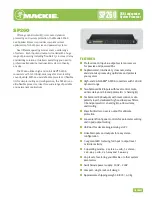
EDS-728 Series User’s Manual
Featured Functions
3-30
Differences between RSTP and STP
RSTP is similar to STP, but includes additional information in the BPDUs that allow each bridge
to confirm that it has taken action to prevent loops from forming when it decides to enable a link
to a neighboring bridge. Adjacent bridges connected via point-to-point links will be able to enable
a link without waiting to ensure that all other bridges in the network have had time to react to the
change. The main benefit of RSTP is that the configuration decision is made locally rather than
network-wide, allowing RSTP can carry out automatic configuration and restore a link faster than
STP.
Using STP on a Network with Multiple VLANs
IEEE Std 802.1D, 1998 Edition, does not take into account VLANs when calculating STP
information—the calculations only depend on the physical connections. Consequently, some
network configurations will result in VLANs being subdivided into a number of isolated sections
by the STP system. You must ensure that every VLAN configuration on your network takes into
account the expected STP topology and alternative topologies that may result from link failures.
Port Speed
Path Cost 802.1D,
1998 Edition
Path Cost
802.1w-2001
10 Mbps
100
2,000,000
100 Mbps
19
200,000
1000 Mbps
4
20,000
The following figure shows an example of a network that contains VLANs 1 and 2. The VLANs
are connected using the 802.1Q-tagged link between Switch B and Switch C. By default, this link
has a port cost of 100 and is automatically blocked because the other Switch-to-Switch
connections have a port cost of 36 (18+18). This means that both VLANs are now
subdivided—VLAN 1 on Switch units A and B cannot communicate with VLAN 1 on Switch C,
and VLAN 2 on Switch units A and C cannot communicate with VLAN 2 on Switch B.
To avoid subdividing VLANs, all inter-switch connections should be made members of all
available 802.1Q VLANs. This will ensure connectivity at all times. For example, the connections
between Switches A and B, and between Switches A and C should be 802.1Q tagged and carrying
VLANs 1 and 2 to ensure connectivity.
See the “Configuring Virtual LANs” section for more information about VLAN Tagging.
















































